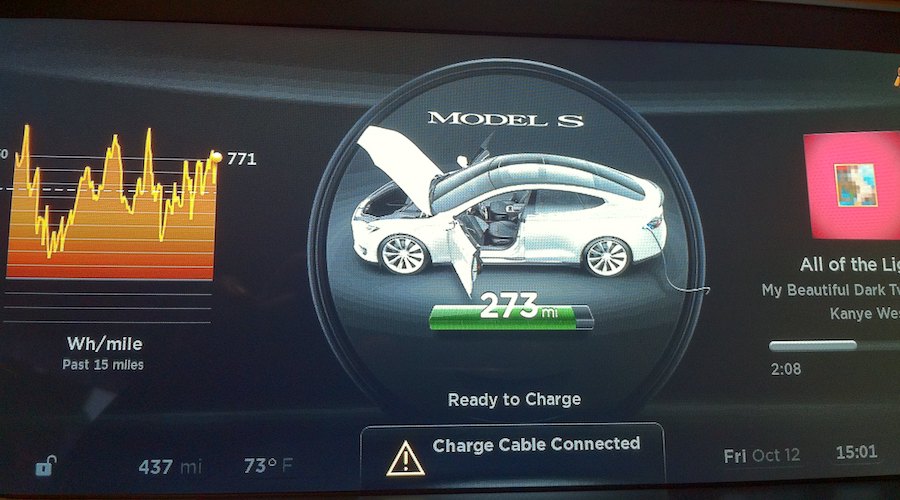Global S&T Development Trend Analysis Platform of Resources and Environment
| Researchers find out what really drives Li-ion battery decay | |
| admin | |
| 2022-05-05 | |
| 发布年 | 2022 |
| 语种 | 英语 |
| 国家 | 国际 |
| 领域 | 地球科学 |
| 正文(英文) |  Tesla Series S – dashboard. (Reference image by Wesley Fryer, Flickr).
Researchers at the US Department of Energy’s SLAC National Accelerator Laboratory, Purdue University, Virginia Tech, and the European Synchrotron Radiation Facility have discovered that the factors behind lithium-ion battery decay change over time. In a paper published in the journal Science, the group explains that early on, decay seems to be driven by the properties of individual electrode particles, but after several dozen charging cycles, it’s how those particles are put together that matters more. “The fundamental building blocks are these particles that make up the battery electrode, but when you zoom out, these particles interact with each other,” Yijin Liu, senior author of the paper, said in a media statement. Therefore, “if you want to build a better battery, you need to look at how to put the particles together.” With that goal in mind, Liu and colleagues decided to not just look at individual particles but also at the ways they work together to prolong – or degrade – battery life. “Battery particles are like people – we all start out going our own way,” Keije Zhao, co-senior author of the study said. “But eventually we encounter other people and we end up in groups, going in the same direction. To understand peak efficiency, we need to study both the individual behaviour of particles and how those particles behave in groups.” Using X-rays to look deeperTo explore this idea further, the scientists used X-ray tomography to reconstruct three-dimensional pictures of the cathodes after they had gone through either 10 or 50 charging cycles. They cut up those 3D pictures into a series of 2D slices and used computer vision methods to identify particles. They were then able to identify more than 2,000 individual particles, for which they calculated not only individual particle features such as size, shape and surface roughness but also more global traits, such as how often particles came into direct contact with each other and how varied the particles’ shapes were. Next, they looked at how each of those properties contributed to particles’ breakdown, and a pattern emerged. After 10 charging cycles, the biggest factors were individual particles’ properties, including how spherical the particles were and the ratio of particle volume to surface area. After 50 cycles, however, pair and group attributes – such as how far apart two particles were, how varied their shapes were and whether more elongated, football-shaped particles were oriented similarly – drove particle breakdown. “It’s no longer just the particle itself. It’s particle-particle interactions that matter,” Liu said. In his view, this is important because it means manufacturers could develop techniques to control such properties. For example, they might be able to use magnetic or electric fields to align elongated particles with each other, which the new results suggest would result in longer battery life. “This study really sheds light on how we can design and manufacture battery electrodes to obtain long cycle life for batteries,” co-author Feng Lin said. “We are excited to implement the understanding to next-generation, low-cost, fast-charging batteries.”
|
| URL | 查看原文 |
| 来源平台 | Minging.com |
| 文献类型 | 新闻 |
| 条目标识符 | http://119.78.100.173/C666/handle/2XK7JSWQ/348509 |
| 专题 | 地球科学 |
| 推荐引用方式 GB/T 7714 | admin. Researchers find out what really drives Li-ion battery decay. 2022. |
| 条目包含的文件 | 条目无相关文件。 | |||||
| 个性服务 |
| 推荐该条目 |
| 保存到收藏夹 |
| 查看访问统计 |
| 导出为Endnote文件 |
| 谷歌学术 |
| 谷歌学术中相似的文章 |
| [admin]的文章 |
| 百度学术 |
| 百度学术中相似的文章 |
| [admin]的文章 |
| 必应学术 |
| 必应学术中相似的文章 |
| [admin]的文章 |
| 相关权益政策 |
| 暂无数据 |
| 收藏/分享 |
除非特别说明,本系统中所有内容都受版权保护,并保留所有权利。
修改评论